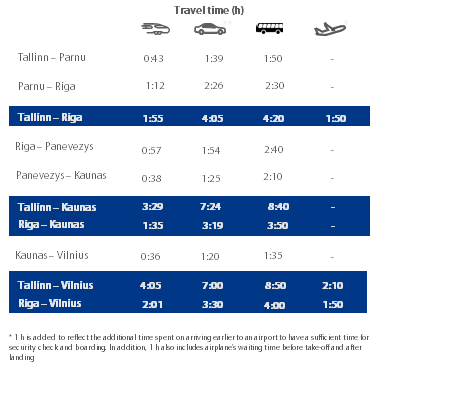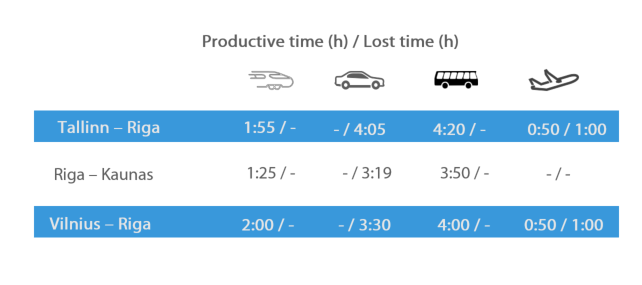Rail Baltica is going to bring a completely new travel experience to Baltic passengers that cannot be compared to any of the existing means of transportation in the region. What is more, the newly built fast conventional railway infrastructure will revolutionize people’s lives by changing their habits and widening opportunities. The new railway will bring a completely new level of travel safety, time and comfort.
Safety
- Technological advancements in the rail industry have made railway transportation one of the safest modes of transport.
- Improved travel safety and avoidance of casualties by shifting from other transport modes to rail – the average fatality rate travelling by train is 28.5 times lower compared to road vehicles and is 2.7 times lower compared to public buses.
- Another safe alternative for travelling under limiting medical conditions.
Train journeys also help to avoid deaths and road accidents that are caused by multitasking while driving. Rail travel is suitable not only for people with busy lifestyles, as it does not require a traveller to fully concentrate on the road, but it is also the best possible opportunity to get to a destination for someone suffering from certain medical conditions that require special travelling comfort and speed. Rail Baltica would provide a safer and faster travel alternative to reach the best healthcare solutions within the Baltics, taking into account flying restrictions that are often assigned to certain medical conditions.
Safety is an aspect of the travel experience that has gained a lot of attention recently. The Rail Baltica Global Cost-Benefit Analysis (CBA) shows that shifting from other transport modes to rail will greatly improve general travel safety. According to the data of the European Railway Agency, the average fatality rate while travelling by train is 28.5 times lower in comparison with road vehicles and is 2.7 times lower compared to public buses.
Time
- Travel time savings – Rail Baltica has a significant advantage compared to cars (up to 3 hours saved) and buses (up to 5 hours saved) travelling between the Baltic furthest capitals, and is as time efficient as air journeys within the Baltics due to the peculiarities of the aviation industry.
- Time savings lead to cost savings also for individuals.
- By reducing the amount of travel time, rail travel maximizes the time that can be spent at the destination.
- Travel opportunities and times are not affected by severe weather conditions often observed in the Baltics.
- Seamless center-to-center travel offers a more efficient travel experience, bringing passengers to the city center right away.
In comparison to other means of transportation such as airplanes, cars or buses, a fast conventional railway offers higher resistance to severe weather conditions that are quite often observed in the Baltic region. Rail transport also offers complete independence from congestion caused by large events and accidents on Via Baltica. The reliability of transport arriving and departing at precise times are of high importance for the modern lifestyle as it allows the planning of complex connecting travels, as well as leisure activities at the final destination, without having to worry.
Rail Baltica should not just be looked at as a single component of a new travel experience, instead it should also be considered as an improvement to the overall transport infrastructure. Improved connectivity between the Baltic States will provide the opportunity for tourists to maximize their time in each Baltic country, while minimizing their travelling time between the destinations.
The Rail Baltica CBA also shows that, in the case of the Baltic region, the assumption that air travel provides the biggest passenger time savings is inaccurate. For most of the trips between neighbouring countries it will take less time to travel by rail than by air. Comparing travel time between cars and Rail Baltica on the route between the three capitals, the new railway would save roughly 3 hours. As for bus travels, almost 5 hours would be saved.
Productive Travel
- High productive use of travel time can also be expressed in monetary value – although trains might have a faster overall travel time, the peculiarities of the aviation industry reduces the amount of productive travel time by almost half.

The introduction of Rail Baltica services would open up a new type of travel experience – productive travel. Even though planes are a very fast option for travelling, a large portion of the travel time is lost due to security checks and boarding time at the airport. However, for a single traveller using a car, the whole travel time is lost due to the need to exclusively concentrate on driving, hence no other value adding activity is possible while sitting behind the wheel. In comparison, trains are a mode of transportation that offer a relatively low proportion of lost time during the journey, and also offer a convenient environment for work, studies or the fulfilment of other tasks. The example of the Toronto to Montreal journey with Via Rail Canada proved that the rail travel consisted of approximately 5 hours of productive time, while the plane journey provided approximately 1:15 hours, and the car journey didn’t give any opportunity whatsoever for productive time while travelling.
Comfort
- Conventional railway carriages provide some of the most comfortable seating, widest areas for legroom and personal space with large fixed tables.
- Easy access to electricity and internet, food and drink services, and other comfort increasing services.
- Integrated passenger travel solutions with a door-to-door service.
Today modern passenger railway carriages provide comfortable seating, wide areas for legroom and more personal space overall. Furthermore, it is common for passenger railway carriages to provide larger fixed tables in comparison to those available on air or road public transportation services. In addition, while travelling with fast conventional railway such comforts as electricity outlets, food and drink services, rest rooms and other service level increasing facilities and services are available. Moreover, train journeys tend to be smoother than air as they have no landing, take-off and turbulence zones. Road journeys, however, depend on the road quality that in case of the Baltics is relatively poor.
Wider Opportunities
Travel time savings bring communities closer together and invite inhabitants to:
- expand labour opportunities
- expand academic possibilities
- expand opportunities for culture and entertainment
- reap the benefits of the different Baltic taxation systems
- access the best retail offers within the region
- reap the benefits of different medical offers and levels of development within the region
- expand touristic opportunities and have weekend trips within the region.
Work and Study Elsewhere
The travel time savings provided by the fast conventional railway infrastructure will bring the Baltic communities closer together and allow inhabitants to access a wider employment market or more favourable study opportunities as there are around 600 universities within the Baltic States, Poland and Finland. It will now be possible to work or study in one country and own property in another, if there is a favourable difference in business environment, living conditions or cost.
Weekend trips
Easy access to fast conventional railway will not only extend the number of possible weekend destinations, but it will also positively affect the level of tourism opportunities within the region. Large infrastructure projects tend to also affect the retail industry, as in the case of the Channel Tunnel between the UK and France. Due to differences in tax rates and offers, shopping trips will become an integral part of the added value of Rail Baltica and yet another reason for a weekend trip.
Medical tourism
Better access to healthcare institutions not only makes them more competitive by increasing their catchment area, but also gives the opportunity for people to choose the best available healthcare in a larger area According to the Eurobarometer, the satisfaction with healthcare quality between the Baltic States differs as much as 20%. There are surgeries and procedures that are not performed in one country but are performed in another due to the availability of facilities and experienced medical staff. Taking this into the account, Pan-Baltic health tourism has potential.
At the same time, there is the potential to attract medical tourists from Scandinavia, the Commonwealth of Independent States and Western European countries, driven by competitive prices, well-educated experts and the high quality of service.
The material is based on Rail Baltica Global Cost-Benefit Analysis (CBA) prepared by EY.
